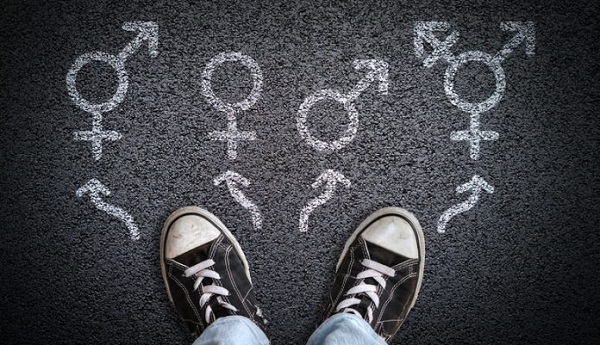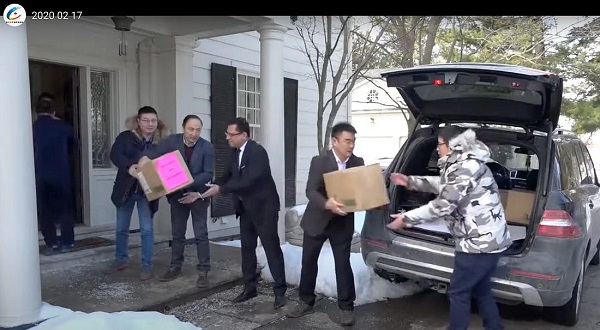Business
Report: $128 million in federal grants spent on gender ideology

From The Center Square
By
More than $128 million of federal taxpayer money was spent on at least 341 grants to fund gender ideology initiatives under the Biden administration, according to an analysis of federal data by the American Principles Project.
In, “Funding Insanity: Federal Spending on Gender Ideology under Biden-Harris,” APP says it “found how the federal government has been spending hundreds of millions of YOUR MONEY on the Gender Industrial Complex!”
APP says it identified the grants by searching the USA Spending database. The data, which is available for free, is categorized by federal agency; notable grants are highlighted.
The U.S. Health and Human Services Department awarded the greatest amount of funding totaling nearly $84 million through 60 grants.
The Department of State awarded the greatest number of grants, 209, totaling more than $14 million, according to the data.
Other agencies awarding taxpayer-funded gender ideology grants include:
- U.S. Agency for International Development, nearly $18 million through 8 grants;
- National Endowment for the Humanities, more than $2.6 million through 20 grants;
- Department of Justice, $1.9 million through three grants;
- Institute of Museum and Library Services, $1.87 million through 13 grants;
- Department of Education, $1.67 million through two grants;
- Department of Agriculture, $1.6 million through five grants;
- Department of the Interior, more than 1,000,000 awarded through two grants;
- U.S. Department of Housing and Urban Development, more than $548,000 through 4 grants;
- Inter-American Foundation, more than $490,000 through two grants;
- National Endowment for the Arts, $262,000 through 13 grants.
APP also identified 63 federal agency contracts totaling more than $46 million that promote gender ideology. They include total obligated amounts and the number of contracts per agency.
The majority, $31 million, was awarded through USAID. The next greatest amount of $4.4 million was awarded through the Department of Defense.
The Trump administration has taken several approaches to gut USAID, which has been met with litigation. The Department of Defense and other agencies are also under pressure to cut funding and reduce redundancies.
Notable grants include:
- $3.9 million to Key Populations Consortium Uganda for promoting “the safety, agency, well-being and the livelihoods of LGBTQI+ in Uganda;”
- $3.5 million to Outright International for “the Alliance for Global Equality and its mission to promote LGBTQI+ people in priority countries around the world;”
- $2.4 million to the International Rescue Committee for “inclusive consideration of sexual orientation, gender identity, and sexual characteristics in humanitarian assistance;”
- $1.9 million to the American Bar Association to “shield the LGBTQI+ population in the Western Balkans;”
- $1.4 million for “economic empowerment of and opportunity for LGBTQI+ people in Serbia;”
- $1.49 million to Equality for All Foundation, Jamaica to “Strengthen community support structures to upscale LGBT rights advocacy;”
- More than $1 million to Bandhu Social Welfare Society to support gender diverse people in Bangladesh.
One of the grants identified by APP, which has since been cancelled, was $600,000 from the U.S. Department of Agriculture to Southern University Agricultural & Mechanical College in Baton Rouge, Louisiana, to study menstruation and menopause, including in biological men.
According to a description of the grant summary, funding would support research, extension, and teaching to address “growing concerns and issues surrounding menstruation, including the potential health risks posed to users of synthetic feminine hygiene products (FHP);” advancing research in the development of FHP that use natural materials and providing menstrual hygiene management; producing sustainable feminine hygiene sanitary products using natural fibers; providing a local fiber processing center for fiber growers in Louisiana, among others.
It states that menstruation begins in girls at roughly age 12 and ends with menopause at roughly age 51. “A woman will have a monthly menstrual cycle for about 40 years of her life averaging to about 450 periods over the course of her lifetime,” but adds: “It is also important to recognize that transgender men and people with masculine gender identities, intersex and non-binary persons may also menstruate.”
All federal funding was allocated to state agencies through the approval of Congress when it voted to pass continuing resolutions to fund the federal government and approved agency budgets.
Alberta
Made in Alberta! Province makes it easier to support local products with Buy Local program

Show your Alberta side. Buy Local. |
When the going gets tough, Albertans stick together. That’s why Alberta’s government is launching a new campaign to benefit hard-working Albertans.
Global uncertainty is threatening the livelihoods of hard-working Alberta farmers, ranchers, processors and their families. The ‘Buy Local’ campaign, recently launched by Alberta’s government, encourages consumers to eat, drink and buy local to show our unified support for the province’s agriculture and food industry.
The government’s ‘Buy Local’ campaign encourages consumers to buy products from Alberta’s hard-working farmers, ranchers and food processors that produce safe, nutritious food for Albertans, Canadians and the world.
“It’s time to let these hard-working Albertans know we have their back. Now, more than ever, we need to shop local and buy made-in-Alberta products. The next time you are grocery shopping or go out for dinner or a drink with your friends or family, support local to demonstrate your Alberta pride. We are pleased tariffs don’t impact the ag industry right now and will keep advocating for our ag industry.”
Alberta’s government supports consumer choice. We are providing tools to help folks easily identify Alberta- and Canadian-made foods and products. Choosing local products keeps Albertans’ hard-earned dollars in our province. Whether it is farm-fresh vegetables, potatoes, honey, craft beer, frozen food or our world-renowned beef, Alberta has an abundance of fresh foods produced right on our doorstep.
Quick facts
- This summer, Albertans can support local at more than 150 farmers’ markets across the province and meet the folks who make, bake and grow our food.
- In March 2023, the Alberta government launched the ‘Made in Alberta’ voluntary food and beverage labelling program to support local agriculture and food sectors.
- Through direct connections with processors, the program has created the momentum to continue expanding consumer awareness about the ‘Made in Alberta’ label to help shoppers quickly identify foods and beverages produced in our province.
- Made in Alberta product catalogue website
Related information
2025 Federal Election
ASK YOURSELF! – Can Canada Endure, or Afford the Economic Stagnation of Carney’s Costly Climate Vision?

From Energy Now
By Tammy Nemeth and Ron Wallace
Carney’s Costly Climate Vision Risks Another “Lost Liberal Decade”
A carbon border tax isn’t the simple offset it’s made out to be—it’s a complex regulatory quagmire poised to reshape Canada’s economy and trade. In its final days, the Trudeau government made commitments to mandate climate disclosures, preserve carbon taxes (both consumer and industrial) and advance a Carbon Border Adjustment Mechanism (CBAM). Newly minted Prime Minister Mark Carney, the godfather of climate finance, has embraced and pledged to accelerate these commitments, particularly the CBAM. Marketed as a strategic shift to bolster trade with the European Union (EU) and reduce reliance on the U.S., a CBAM appears straightforward: pay a domestic carbon price, or face an EU import fee. But the reality is far more extensive and invasive. Beyond the carbon tariffs, it demands rigorous emissions accounting, third-party verification and a crushing compliance burden.
Although it has been little debated, Carney’s proposed climate plan would transform and further undermine Canadian businesses and the economy. Contrary to Carney’s remarks in mid-March, the only jurisdiction that has implemented a CBAM is the EU, with implementation not set until 2026. Meanwhile, the UK plans to implement a CBAM for 1 January 2027. In spite of Carney’s assertion that such a mechanism will be needed for trade with emerging Asian markets, the only Asian country that has released a possible plan for a CBAM is Taiwan. Thus, a Canadian CBAM would only align Canada with the EU and possibly the UK – assuming that those policies are implemented in face of the Trump Administrations’ turbulent tariff policies.
With the first phase of the EU’s CBAM, exporters of cement, iron and steel, aluminum, fertiliser, electricity and hydrogen must have paid a domestic carbon tax or the EU will charge more for those imports. But it’s much more than that. Even if exporting companies have a domestic carbon tax, they will still have to monitor, account for, and verify their CO2 emissions to certify the price they have paid domestically in order to trade with the EU. The purported goal is to reduce so-called “carbon leakage” which makes imports from emission-intensive sectors more costly in favour of products with fewer emissions. Hence, the EU’s CBAM is effectively a CO2 emissions importation tariff equivalent to what would be paid by companies if the products were produced under the EU’s carbon pricing rules under their Emissions Trading System (ETS).
While that may sound simple enough, in practice the EU’s CBAM represents a significant expansion of government involvement with a new layer of bureaucracy. The EU system will require corporate emissions accounting of the direct and indirect emissions of production processes to calculate the embedded emissions. This type of emissions accounting is a central component of climate disclosures like those released by the Canadian Sustainability Standards Board.
Hence, the CBAM isn’t just a tariff: It’s a system for continuous emissions monitoring and verification. Unlike traditional tariffs tied to product value, the CBAM requires companies exporting to the EU to track embedded emissions and submit verified data to secure an EU-accredited verification. Piling complexity atop cost, importers must then file a CBAM declaration, reviewed and certified by an EU regulatory body, before obtaining an import certificate.
This system offers little discernible benefit for the environment. The CBAM ignores broader environmental regulatory efforts, fixating solely on taxation of embedded emissions. For Canadian exporters, Carney’s plan would impose an expensive, intricate web of compliance monitoring, verification and fees accompanied by uncertain administrative penalties.
Hence, any serious pivot to the EU to offset trade restrictions in the U.S. will require a transformation of Canada’s economy, one with a questionable return on investment. Carney’s plan to diversify and accelerate trade with the EU, whose economies are increasingly shackled with burdensome climate-related policies, ignores the potential of successful trade negotiations with the U.S., India or emerging Asian countries. The U.S., our largest and most significant trading partner, has abandoned the Paris Climate Agreement, ceased defence of its climate-disclosure rule and will undoubtedly be seeking fewer, not more, climate-related tariffs. Meanwhile, despite rulings from the Supreme Court of Canada, Carney has doubled down on his support for the Trudeau governments’ Impact Assessment Act (Bill C-69) and confirmed intentions to proceed with an emissions cap on oil and gas production. Carney’s continuance of the Trudeau governments’ regulatory agenda combined with new, proposed trade policies will take Canada in directions not conducive to future economic growth or to furthering trade agreements with the U.S.
Canadians need to carefully consider whether or not Canada can endure, or afford, Carney’s costly climate vision that risks another “lost Liberal decade” of economic stagnation?
Tammy Nemeth is a U.K.-based strategic energy analyst.
Ron Wallace is an executive fellow of the Canadian Global Affairs Institute and the Canada West Foundation.
-

 2025 Federal Election2 days ago
2025 Federal Election2 days agoConservative Party urges investigation into Carney plan to spend $1 billion on heat pumps
-

 Health2 days ago
Health2 days agoExpert Medical Record Reviews Of The Two Girls In Texas Who Purportedly Died of Measles
-

 2025 Federal Election2 days ago
2025 Federal Election2 days agoCorporate Media Isn’t Reporting on Foreign Interference—It’s Covering for It
-

 2025 Federal Election2 days ago
2025 Federal Election2 days agoMark Carney To Ban Free Speech if Elected
-

 2025 Federal Election2 days ago
2025 Federal Election2 days agoPoilievre will make it harder for politicians to boost their portfolios, close Carney loopholes
-

 2025 Federal Election1 day ago
2025 Federal Election1 day agoPPE Videos, CCP Letters Reveal Pandemic Coordination with Liberal Riding Boss and Former JCCC Leader—While Carney Denies Significant Meeting In Campaign
-

 2025 Federal Election1 day ago
2025 Federal Election1 day agoNo Matter The Winner – My Canada Is Gone
-

 2025 Federal Election2 days ago
2025 Federal Election2 days agoMark Carney Vows Internet Speech Crackdown if Elected






